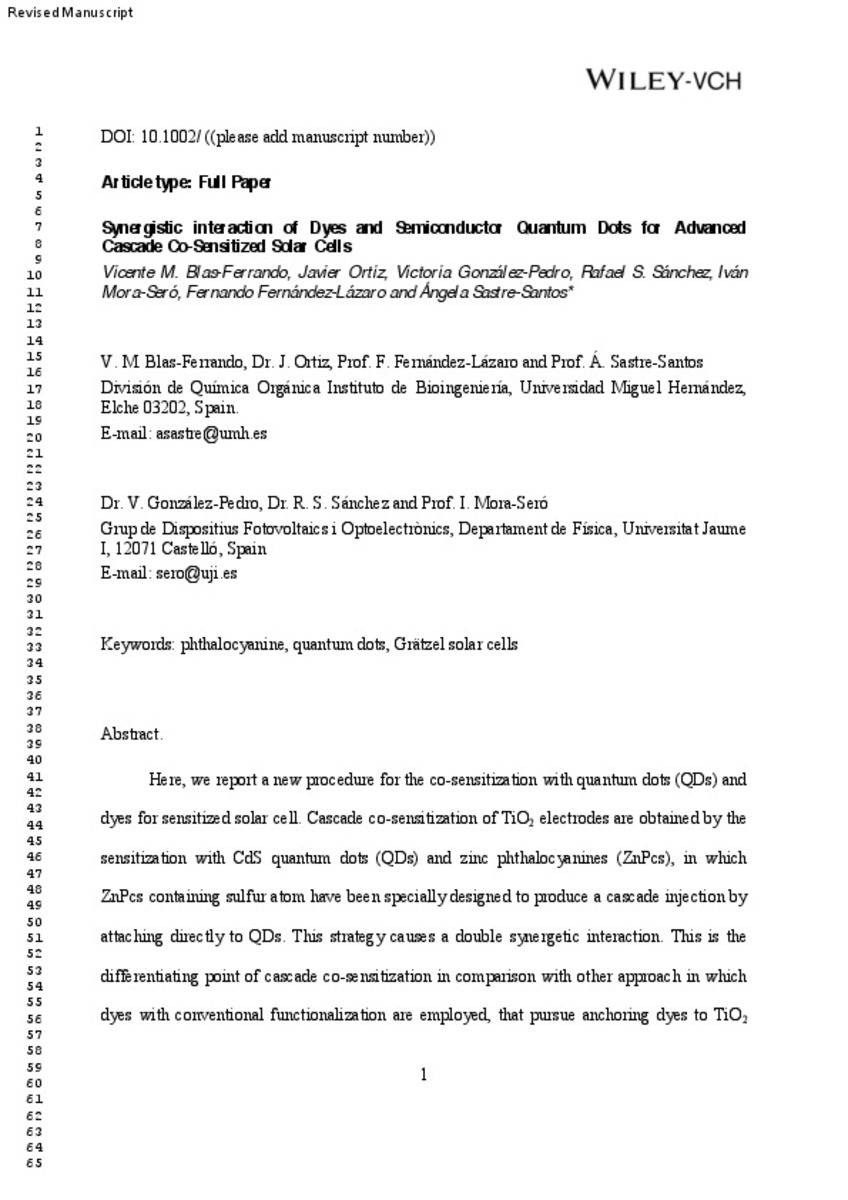Mostrar el registro sencillo del ítem
Synergistic Interaction of Dyes and Semiconductor Quantum Dots for Advanced Cascade Cosensitized Solar Cells
| dc.contributor.author | Blas Ferrando, Vicente M. | |
| dc.contributor.author | Ortiz, Javier | |
| dc.contributor.author | González Pedro, Victoria | |
| dc.contributor.author | S. Sánchez, Rafael | |
| dc.contributor.author | Mora-Sero, Ivan | |
| dc.contributor.author | Fernández Lázaro, Fernando | |
| dc.contributor.author | Sastre Santos, Ángela | |
| dc.date.accessioned | 2016-02-16T10:32:08Z | |
| dc.date.available | 2016-02-16T10:32:08Z | |
| dc.date.issued | 2015-06-03 | |
| dc.identifier.citation | BLAS FERRANDO, Vicente M.; ORTIZ, Javier; GONZÁLEZ PEDRO, Victoria; SÁNCHEZ SÁNCHEZ, Rafael; MORA SERÓ, Iván; FERNÁNDEZ LÁZARO, Fernando; SASTRE SANTOS, Ángela. Synergistic Interaction of Dyes and Semiconductor Quantum Dots for Advanced Cascade Cosensitized Solar Cells. Advanced Functional Materials (2015), v. 25, n. 21, pp. 3220–3226 | ca_CA |
| dc.identifier.uri | http://hdl.handle.net/10234/149945 | |
| dc.description.abstract | A new procedure for the cosensitization with quantum dots (QDs) and dyes for sensitized solar cells is reported here. Cascade cosensitization of TiO2 electrodes is obtained by the sensitization with CdS QDs and zinc phthalocyanines (ZnPcs), in which ZnPcs containing a sulfur atom are specially designed to produce a cascade injection by direct attachment to QDs. This strategy causes a double synergetic interaction. This is the differentiating point of cascade cosensitization in comparison with other approaches in which dyes with conventional functionalization are anchored to TiO2 electrodes. Cosensitization produces a panchromatic response from the visible to near-IR region already observed with other sensitization strategies. However, cascade cosensitization produces in addition a synergistic interaction between QDs and dye, that it is not merely limited to the complementary light absorption, but dye enhances the efficiency of QD sensitization acting as a passivating agent. The cascade cosensitization concept is demonstrated with using [Co(phen)3]3+/2+ redox electrolyte. The TiO2/CdS QD-ZnPc/[Co(phen)3]3+/2+ sensitized solar cell shows a large improvement of short-circuit photocurrent and open-circuit voltage in comparison with samples just sensitized with QDs. The advent of such cosensitized QD-ZnPc solar cells paves the way to extend the absorbance region of the promising QD-based solar cells and the development of a new family of molecules designed for this purpose. | ca_CA |
| dc.description.sponsorShip | 1) Ministerio de Economía y Competividad 2) Generalitat Valenciana 3) Universitat Jaume I 4) European FEDER funds (CTQ2011-26455, PROMETEO 2012/010, ACOMP/2013/024, ISIC/2012/008, and UJI 12I361.01/1) | ca_CA |
| dc.format.extent | 29 p. | ca_CA |
| dc.format.mimetype | application/pdf | ca_CA |
| dc.language.iso | eng | ca_CA |
| dc.publisher | Wiley | ca_CA |
| dc.relation.isPartOf | Advanced Functional Materials (2015), v. 25, n. 21 | ca_CA |
| dc.rights.uri | http://rightsstatements.org/vocab/CNE/1.0/ | * |
| dc.subject | Phthalocyanine | ca_CA |
| dc.subject | Quantum dots | ca_CA |
| dc.subject | Grätzel solar cells | ca_CA |
| dc.title | Synergistic Interaction of Dyes and Semiconductor Quantum Dots for Advanced Cascade Cosensitized Solar Cells | ca_CA |
| dc.type | info:eu-repo/semantics/article | ca_CA |
| dc.identifier.doi | http://dx.doi.org/10.1002/adfm.201500553 | |
| dc.rights.accessRights | info:eu-repo/semantics/openAccess | ca_CA |
| dc.relation.publisherVersion | http://onlinelibrary.wiley.com/doi/10.1002/adfm.201500553/full | ca_CA |
| dc.edition | Postprint | ca_CA |
| dc.type.version | info:eu-repo/semantics/acceptedVersion |
Ficheros en el ítem
Este ítem aparece en la(s) siguiente(s) colección(ones)
-
FCA_Articles [507]
Articles de publicacions periódiques







